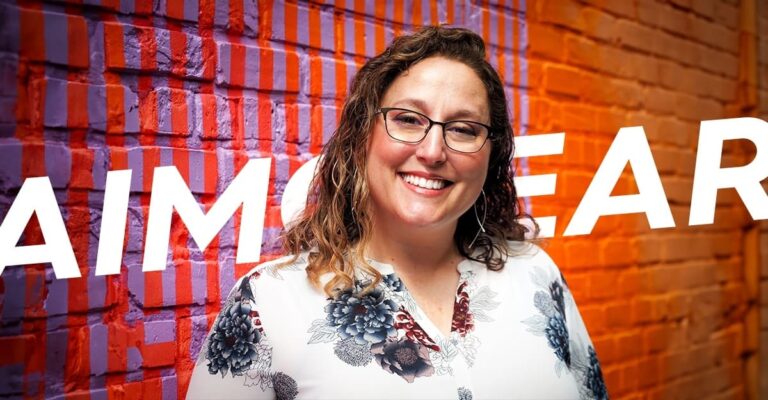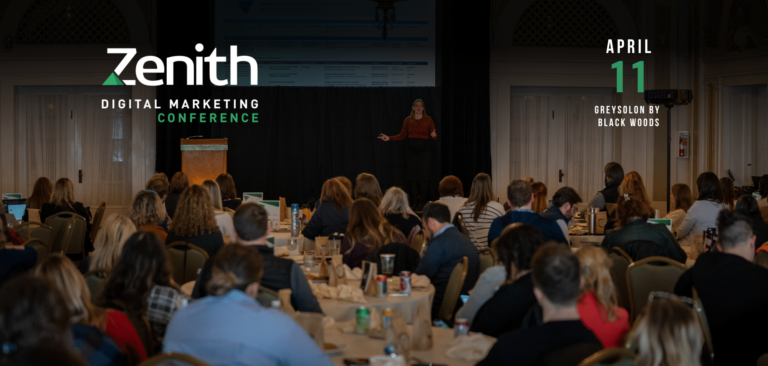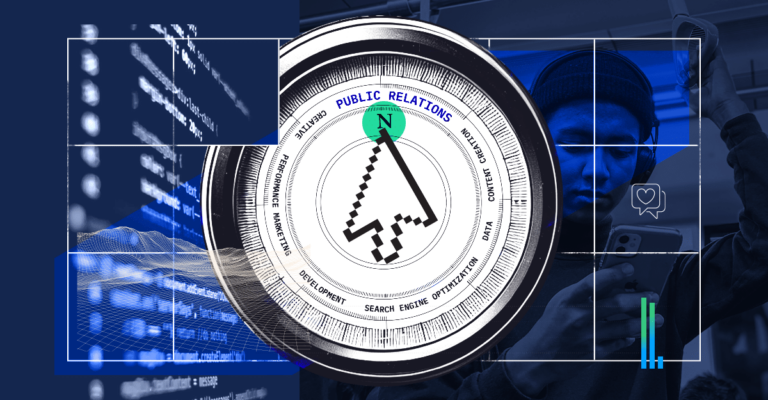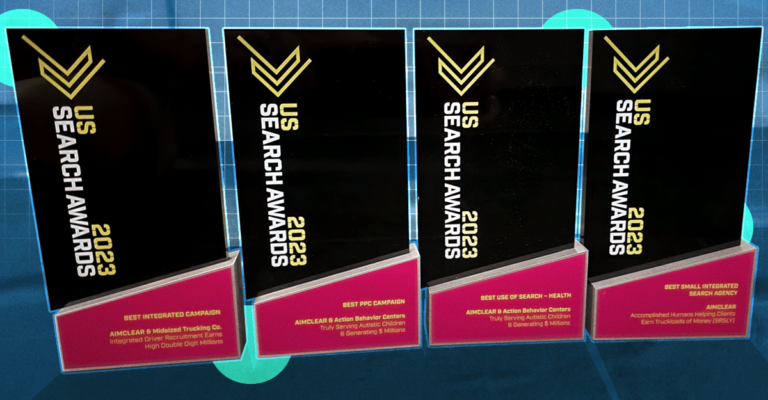Welcome back! Day two of #SESSF live coverage continued with CEO of TopRank Online Marketing, Lee Odden’s presentation on Optimizing B2B Content Across the Sales Cycle. Lee did not go to the Search Bash networking event which means he A) missed out on the flash mob routine and B) was wide awake and raring to go with the anticipation of providing some stellar optimization information that without a doubt woke up the crowd. In case you missed out on this track, take a look at AIMCLEAR‘s full recap below!
Lee started out by asking the audience what they have dipped their toes in?
- SEO?
- Social Media?
- Content Marketing?
- Customer Segmentation?
- Sales Cycle Content Mapping?
Lee’s presentation was about tying all of those things together. It’s all about ‘Ubiquitous Connectivity.’
Did you know that by 2020, there will be 50 billion connected devices? No more lazy Sunday afternoons, people! Expect to be always on, all the time, everywhere… this somewhat not-shocking statistic presents an interesting scenario – everyone, not just brands can and will be publishers of content. We have access to the tools to create, consume, publish, interact, and transact. This creates for a very interesting environment.
As a company, you are now competing with your customers and not just your competitors. Because of this, you need to find opportunities to stand out.
Ninety percent of B2B marketers are using content marketing tactics to grow their business. You need to anticipate a longer sales cycle – use more information to nurture leads so that you are far more qualified by the time of the transaction.
Ask yourself: What are your customers doing? Is it social media, articles, case studies, live events, blogs, Twitter, videos, infographics?!?!
Look to see if your content marketing tactics are integrated. Lee asked, what the hell does an infographic or blog post have to do with the overall story of what you are trying to tell? What are you doing to attract, engage, and convert prospects into customers? Hey! Here is an idea – create an editorial plan that guides it all together.
Now, ask yourself: Is the content optimized? Do your content marketing tactics align with each other? Do they build on each other? REMEMBER: Optimized and integrated content is POWERFUL.
So let’s do the math – Customer goals + business value = a content marketing strategy. No need for a flash card with that equation.
DON’T just look at your product and push out the product’s features and benefits. But rather, understand why people buy your product and once you understand those reasons create content around that.
Simply: you meet customer needs, you achieve business outcomes.
So, who are your customers? Best? Worst? In-between? What are their characteristics? And what can you do so they can get what they want and you can get what you want?
Lee provided the example of an avatar “Admin Jane.” What is important to “Admin Jane?” Speed. Why is speed important to her? Because it frees up her time to do something else. What is that something else? Find it out and write about that!
Once your prospects becomes customers, you must retain them! Turn them into an advocate for your brand to that they will pass along your information to their network of people.
Create a content plan based on what your customer needs and don’t be vain – remember, it’s not all about you! AND do this across the entire sales cycle. If you want your company to be known as ‘fast,’ then make that category in your plan OR if it is a major platform within your business then turn it into an entire blog focused around it… push it out on your company Facebook page or a resource page on your website. KNOW that your distribution channels are your friends – determine what is relevant to the people you are trying to engage with or the people that influence them.
Lee was kind enough to offer a link to some pretty great marketing content tactics. Be sure to check them out.
OK! Let’s talk about SEARCH for a minute – search means more than SEO and optimizing means more than SEO. A great thing at the tips of our fingers is that we are given the opportunity to optimize AND socialize for search. Keep in mind it is a continuous cycle – outlined perfectly below:
- Hypothesis
- Plan
- Implement
- Measure
- Refine
- Repeat!
This is relevant to any department in a corporation. To optimize is relevant to all and is not just valuable to customer acquisition – marketing, PR, HR, customer service, etc., they are all important! Why wouldn’t you want to bake in an optimization content strategy into all of these departments? If you are able to deflect costs or lower the number of calls your company receives because a prospect or customer is able to Google something you provided that solves his or her issue, that saves your company time. And let’s face it… who doesn’t love a little more time in the day?
There is a notion of a customer’s journey – Content Optimization Trilogy
- How is it that they discover content?
- Empathetic towards how they consume content? What formats? Is it video? And what devices? What are more useful or prone to your target audience?
- What kind of content will motivate your audience to take action? Social share or referring your company? Word of mouth is still the most powerful form of advertising.
According a recent survey Lee brought up:
- 81 percent of B2B buyers are using search engines
- 35 percents are using the vendor website
- 35 through industry guides
- 23 with social media.
So what are they looking at on those outlets?
- 88 percent are reading white papers
- 73 percent with webinars
- 67 percent through case studies, etc.
What devices are they using?
- 84 percent are using laptops
- 61 percent a mobile phone or tablet
- 30 percent are using a desktop.
Again ask yourself, what is the customer journey and is it optimized?
Take a look at the traditional sales funnel:
- Awareness
- Interest
- Consideration
- Purchase
Lee asked to go beyond the simple sales cycle and optimize across the customer lifecycle,which in the end can make a HUGE impact.
- Awareness
- Considerations
- Purchase
- Retention
- Advocacy
There is a sales cycle optimization disconnect – it is not the media format that is more important, it is the info – format and timing! People often over emphasize the platform over the message – don’t! Define the story to motivate and guide people through the sales cycle.
B2B Content Mapping is a timeline for a particular audience segment and defines what type of content there is.
Operationalize your optimization! Make it part of the process for a more efficient strategy.
- Who is your customer? – Preferences, pain points, behaviors, etc.
- What do they care about? – Search and social data sources
- What stories will connect? – Editorial calendar, repurpose
- Make it easy to find and share – Social and SEO, networking, PR, Linking
Optimize Customer Segments
You want to align topical needs with content – buying cycle, keywords, social topics, and content type. What you need to understand is that customers and/or prospects rarely follow a linear path. Some spend time with one company, then another and then FINALLY may come to you. It can be very beneficial for to be at then end of the sales cycle and for you to understand what moves a prospect.
Create a content matrix and as you create your content strategy remember to weave themes into the story! From there, create a keyword matrix based on your content matrix. Inform your editorial plan with variations of what people are searching for or talking about on social.
Measure business value with social SEO KPIs (fans, friends, followers, comments, likes, Google pluses, links, SERPs, search traffic, etc.) and business outcomes (share of voice, improve service, shorter sales cycles, increased order, quantity, frequency, more referrals, lower marketing costs, etc.)
A LOT can be influenced!
Lee offered 3 different things to optimize for:
1) Content Media and Discovery – Audience? Goals? Search? Social? Influences? – “Real influence isn’t huge fan and follower counts, it’s niche communities that take action.”
You want an example? Okay. Take the following:
- Audience = Sales, marketing executives
- Keywords = Broad and category
- Content = Resource center, blogs, social content, media
- Optimize = Corporation website, articles, blogs, digital assets, social
- Socialize = Facebook, LinkedIn, Google +, Slideshare, Twitter, You Tube
- Integration = Marketing and PR
- Measure = Non-brand keyword traffic, social KPIs, leads, conversions
SEARCH is a driver of awareness. Understanding pain points and creating content for how to solve that then you can be found through search, referred through social and therefore CREATE AWARENESS.
In the example above, it is a case of hub and spoke. Not only is it efficient to keep you in line topically. Over time as you publish content the communities you are building grow and grow. From an SEO perspective – the more content you post, the more links you build. Amazing, right?! Say goodbye to traditional link building. People will naturally link to your content if you are smart with what you put out there and use your distribution channels for reach.
Approach and KPIs? Customer segment and product keyword strategy drives content. Blogs are the hub. Outposts are for: developing connections, engaging prospects, customers, media and candidates, publishing optimized content, AND promoting content.
Business outcomes, you ask?
- 2,000+ customers, 4+ years
- 700% revenue growth past 2 years
- Fastest growing SaaS after salesforce.com
- SEO and blogs most effective lead gen source
2) Content and Media Consumption – What’s the narrative? How will your content persuade? Formats, search keywords, social topics, editorial calendar. Think about what content and what devices are best for your customer segment.
Another example – YAY!
Company X had no budget to create new videos but was sitting on hundreds of existing videos. What to do? Audit them! Start to develop topics based on developed categories and put that framework together to develop a strategy. Repurpose the existing content and upload over time – plug into your editorial calendar. This is a simple example of taking existing resources and re-purposing it according to a consumption purpose based on research – this satisfies a need of your customer and creates a presence.
3) Content and Media Engagement – what kind of engagement do your customer’s expect? What topics will inspire action along the customer lifecycle?
“Your community will be as interested in your content as the interest you show in the community,” Lee noted.
Okay, okay, ONE more example for your reading pleasure. Take a company that is interested in creating an engagement opportunity where they can actually communicate with one another.
- Target audience that seeks a ‘safe’ environment to be educated on technology topics.
- Content strategy that aligns customer technology needs with editorial plan.
- Audit hundreds of existing content and media assets for re-purposing.
- Develop new content and co-create with partners.
- Develop content that attracts and engages and gives more data for future content opportunities.
This plan helps connect and engage the audience where trust is engendered. This brand is a useful resource for the prospects and grabs them where they might make the purchase. You see how you can add value by creating value?
OPTIMIZATION IS AN APPROACH! Lee offered the acronym ABO – Always Be Optimized. Set a goal, make a plan, implement, monitor and measure, refine and REPEAT.
Lee ended the presentation with these famous last words…”Optimize is a state of mind.”
Groovy 🙂 . Want more information on this topic then be sure to check out Lee’s book, Optimize: How to Attract and Engage More Customers by Integrating SEO, Social Media, and Content Marketing.
Still can’t get enough? Then be sure to check out his recent interview with Forbes on how to outrank your competition on Google.
Thanks Lee for a great presentation and thank you all for checking out this post. Remember to stay tuned for more live #SESSF coverage from myself(@MollyCRyan) and @gretchenegeberg.









